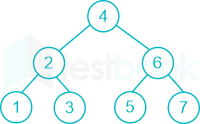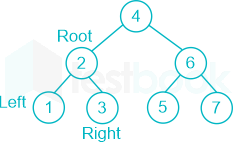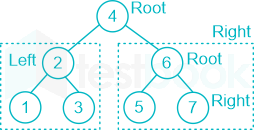- 1. Which of the following statements is INCORRECT with respect to a binary tree?
-
filter_dramaExplanationAnswer is : D
Answer: Option 4
Concept:
Full Binary Tree:
A full binary tree is a binary tree in which each node has exactly two or 0 children.
Complete Binary Tree:
A complete binary tree is a binary tree in which
- except last level tree is completely filled.
- The last level is filled from left to right.
Perfect Binary Tree:
A perfect binary tree is a binary tree in which
- all interior node or internal nodes has 2 children.
- all leaves are at the same level.
Balanced Binary Tree:
A Balanced Binary tree is a binary tree in which at any node height of the left sub tree and right sub tree do not differ by more than 1.
- 2.
A binary tree T has n leaf nodes, the number of nodes of degree 2 in T is:
-
filter_dramaExplanationAnswer is : B
In an "m-ary" tree. the number of total nodes (N) is given by
N=mi + 1 ----(1)
Where,
i: Number of internal nodes
Also, in a tree, N=i + L ----(2)
Where,
L=number of leaf nodes
Here m=2
From equation (1) and equation (2);
N = 2i + 1
2i + 1 = i + L
L = i + 1
The number of leaves are 1 plus the number of internal nodes in binary tree.
Here, given L=n, substitute above and we will get,
i = L - 1
- 3. Which of the following is illegal declaration in C language?
-
filter_dramaExplanationAnswer is : D
Concept –
Option_1: A valid declaration in C.
char *str is a single value which is a pointer to a character. When used as a string in C, it is implied that subsequent characters of the string are stored in subsequent memory addresses, until the end of the string which is marked with a NULL.
Option_2: A valid declaration in C.
Char str[20] is an array of maximum 20 characters. It is similar to char *str except that there is no requirement that the last character in the array be null.
Option_3 – A valid declaration in C.
char str[40] is an array of maximum 40 characters. It is similar to char *str except that there is no requirement that the last character in the array be null.
Option_4: Not a valid declaration in C.
char[] str is a declaration in Java, but not in C. - 4. With respect to linked lists and arrays, which of the following statements is INCORRECT?
-
filter_dramaExplanationAnswer is : A
Answer Option 1
Concept:
Array
Linked Lists ( Singly linked list )
1. Array supports Random access to its elements.
1. Linked list does not support Random access to its elements
2. Array elements are stored in a contiguous manner.
2. Linked list elements are generally not stored in contiguous locations.
3. In Arrays, new elements cannot be added dynamically due to their fixed size.
3. In Linked Lists, an element can be easily added dynamically as the Linked list can dynamically grow or shrink as when needed
4. Inserting a new element in an array is expensive compared to inserting a new element in a linked list. Because size is fixed we have to create a new Array entirely and copy all the elements to a new array along with the new element
4. Inserting a new element in a Linked List is very simple. Just allocate space for the new node and update the references/pointers.
5. Deleting an element from an array is expensive compared to deleting an element from a linked list. Because suppose we want to delete the very first element from the array then we need to shift all the right elements to one position left.
5. Deletion in the linked list is simple just deallocate the node and change the references/pointers.
6. In Arrays there is no extra space/variables is allocated.
6. In the Linked List, pointers are maintained for every node in order to keep track of all the nodes in the list.
Explanation:
Option 1: The linked list is slower in add and remove, but faster in get.
This is the only option that is incorrect since Linked list adding and removing the given element is faster as compared to an array but finding a particular indexed element we might have to traverse to entire list but in case of array random access possible.
- 5. Consider arr [ ] is an array in C language. What will be the effect of "arr++;" ?
-
filter_dramaExplanationAnswer is : D
Answer: Option 4
Explanation:
Consider the following example
#include <stdio.h>
int main()
{
int arr[10] = {1, 2, 3, 4, 5, 6, 7};arr++;
return 0;
}Here arr++; mean that
arr = arr + 1 ;
which is wrong we can not change the base address of an array and it will generate an error.
another way to do that is by using pointers.#include <stdio.h>
int main()
{
int arr[10] = {1, 2, 3, 4, 5, 6, 7};int *p = arr;
p++;
return 0;
}Here int *p = arr; new pointer variable will be created which will start pointing to the first element of the array.
and p++; will cause the pointer to start pointing to the next element of the array.
- 6.
What will be the output of the following C program:(consider int is of 4 bytes and array (arr) starting address is 2000 in decimal )
#include <stdio.h>int main(){int arr[10] = {1, 2, 3, 4, 5, 6, 7, 8, 9, 10};printf("%u\n",(arr+1));printf("%u",(&arr + 1));return 0;} -
filter_dramaExplanationAnswer is : C
Answer: Option 3
Explanation:
- arr denote the Base address of the array.
- &arr will not work the same way as some of you think.
printf("%ld\n",arr+1);
- In the First printf ; arr +1 , addition of 1 resulted in an address increment of 1 int data size hence 2000 + 4 = 2004 will be printed
printf("%ld",(&arr + 1));
- &arr will return a pointer to the whole array of 10 int, addition of 1 resulted in an address with an increment of 4 x 10 = 40 and hence 2040 will be printed in next line.Hence Option 3 is the correct answer.
- 7. Which of the following is the correct declaration of linked list?
-
filter_dramaExplanationAnswer is : B
Declaration syntax: For structure in C and C++
struct tag_name
{
Datatype variable_name;
struct tag_name *pointer_variable;
};
Option 2:
struct node
{
int data;
struct node*link;
}
- 8. In a circularly linked list organization, insertion of a record involves the modification of
-
filter_dramaExplanationAnswer is : C
Circular linked list:
In singly linked lists and doubly linked lists, the end of lists is indicated with a NULL value. But circular linked lists do not have ends. In circular linked lists, each node has a successor, and the last node points to the first node instead of NULL.Example
Let x be a variable pointer and head.
Head is the pointer of the circular linked list.
Now to insert a new record (node) y, we have to loop through the linked list from the head to the last node like this pseudocode below.
x=head
while(x->next!=head)
{
x=x->next;
}
After finishing the loop x is now the last node and we will append the list. y is the next node of x Then the next of y will have to point to the head since the linked list is circular. The pseudocode for this task is below.
x->next=y;
y->next=head;
So There needs modification of two pointers.
So the correct answer is Option 3
- 9. In binary search tree which traversal is used for getting ascending order values?
-
filter_dramaExplanationAnswer is : A
Concept:
By the definition of a Binary Search Tree (BST), the value of left child node <= root node < right child node or left child node < root node <= right child node.
In inorder traversal, we visit left node first, then root node and then right node. Hence, the inorder traversal always returns values in ascending order if it is run on a Binary Search Tree.
Explanation:
Binary Search Tree:

Apply Inorder Traversal

This will print 1-2-3.

This will print 1-2-3-4 and then 1-2-3-4-5-6-7
Output of Traversal: 1-2-3-4-5-6-7 (sorted order)
Important Points:
There are usually three methods of traversing a BST - Preorder, Postorder, Inorder.
- In preorder, we visit nodes in the order of Root -> Left -> Right
- In postorder, we visit nodes in the order of Left -> Right -> Root
- In inorder, we visit nodes in the order of Left -> Root -> Right
- 10.
The for statement
for(expr1 ; expr2 ; expr3) is equivalent to
-
filter_dramaExplanationAnswer is : C
While loop:
In the while loop, the expression is evaluated. If it is non-zero, the statement is executed and the expression is re-evaluated. This cycle continues until expression becomes zero, at which point execution resumes after the statement.
For loop:
In the case of for loop, expr1 is an assignment or function call, expr2 is a relational expression while expr3 is also an assignment or function call. The for loop basically assigns the value to a variable using expr1, expr2 is used to evaluate the expression, and expr3 is used to modify the value of expr2 so that the terminating condition is reached.
This functionality can be achieved using the while statement as listed in option 3.
-
 Rahul Kumar
Rahul Kumar
191 Points
-
VIKRAM JEET
54 Points
-
GEETHIKA CHOWDARY
53 Points
-
sunita saini
52 Points
-
 Zain
Zain
49 Points


